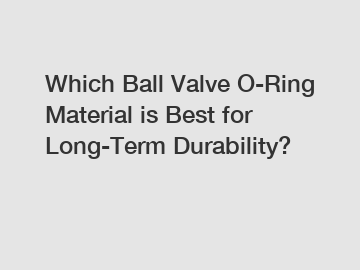Which Ball Valve O-Ring Material is Best for Long-Term Durability?
Which Ball Valve O-Ring Material is Best for Long-Term Durability?
When it comes to selecting the best O-ring material for long-term durability in a ball valve, there are various factors to consider. The choice of O-ring material can greatly impact the performance and lifespan of the ball valve. In this article, we will explore the different O-ring materials commonly used in ball valves, examine their characteristics and performance, and determine the best material for long-term durability.
Nitrile (NBR), commonly known as Buna-N, is one of the most widely used O-ring materials in ball valves. It offers good resistance to oil, water, and common solvents, making it a popular choice in many industries. Nitrile is also cost-effective and readily available, adding to its appeal for various applications. However, while it performs well in many environments, it may not be suitable for more demanding conditions with extreme temperatures or exposure to harsh chemicals.

Fluorocarbon (FKM), also known as Viton®, is another popular O-ring material utilized in ball valves. FKM exhibits exceptional resistance to high temperatures, chemicals, fuels, and solvents. This material is known for its excellent durability and reliability, making it a suitable choice for applications requiring long-term performance in harsh conditions. However, it is worth noting that FKM O-rings may be more expensive than other materials and not as readily available in certain sizes.
A third option for ball valve O-ring materials is silicone (VMQ). Silicone offers good flexibility and resistance to high and low temperatures, making it suitable for a wide range of applications. It also provides excellent resistance to aging and weathering, ensuring long-term durability. However, silicone may not be the best choice for applications involving exposure to fuels, oils, or solvents, as it can experience swelling or degradation in such environments.
To determine the best material for long-term durability, one must consider the specific requirements of the application. Factors such as temperature range, chemical compatibility, pressure conditions, and expected lifespan need to be taken into account. Additionally, it is important to consult the manufacturer's recommendations and guidelines when selecting the appropriate O-ring material for a ball valve.
The choice of O-ring material in a ball valve plays a crucial role in the performance and longevity of the valve. The wrong material selection can lead to premature failures, leaks, and costly downtime. By carefully considering the application requirements and understanding the characteristics and limitations of each O-ring material, one can make an informed decision that ensures long-term durability and reliable operation.
In conclusion, when it comes to selecting the best O-ring material for long-term durability in a ball valve, there are multiple options to consider. Nitrile, fluorocarbon, and silicone are commonly used O-ring materials, each with its own set of advantages and limitations. By evaluating the specific application requirements and performance characteristics of each material, one can make an informed decision to ensure the longevity and reliability of the ball valve.
Contact us to discuss your requirements of Customized Stainless Steel Castings, Stainless Steel Pipe Fitting China, Cencho Valve. Our experienced sales team can help you identify the options that best suit your needs.
205
0
0

Comments
All Comments (0)